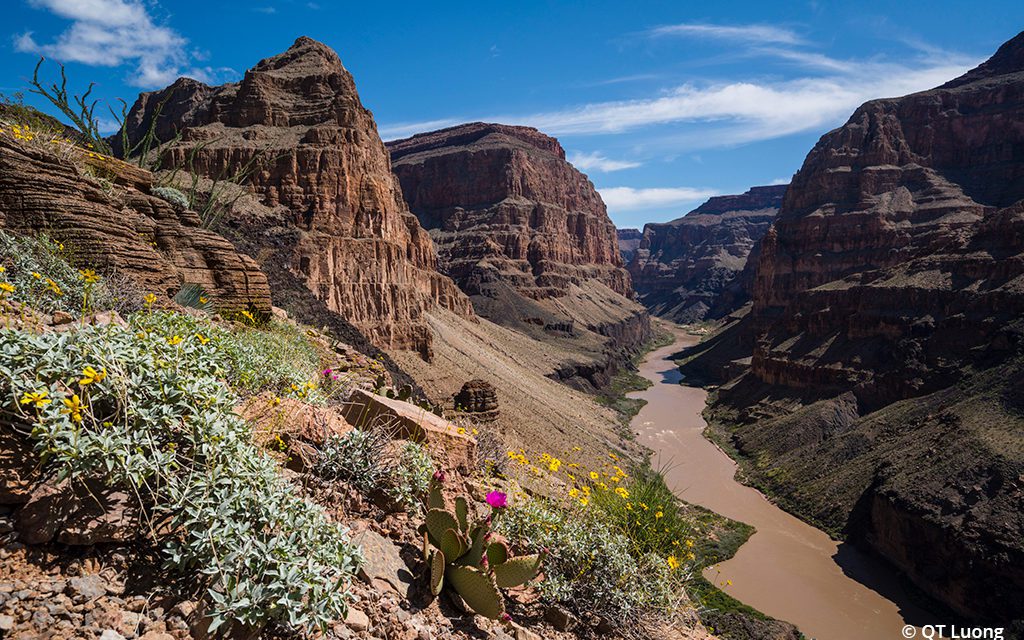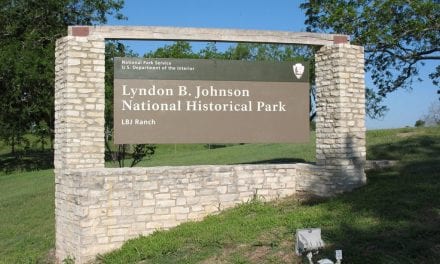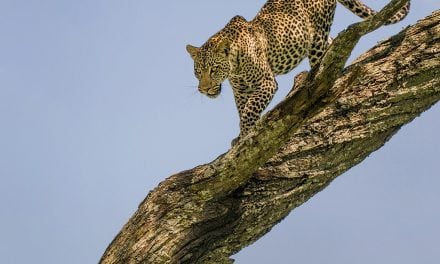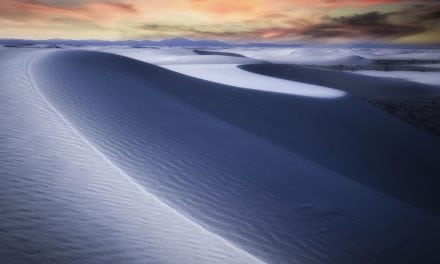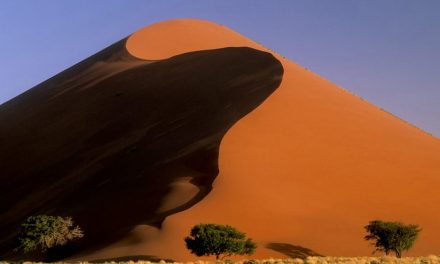The designation of “national monument” evokes statues and memorial buildings that do not sound too interesting for landscape photographers. However, in the United States, the term has a different meaning. What you will find among our national monuments are vast lands rivaling the national parks in beauty, diversity, cultural heritage and unique photographic destinations. You will not find crowds, tight regulations or over-photographed views. Get ready for an adventure off the beaten path.
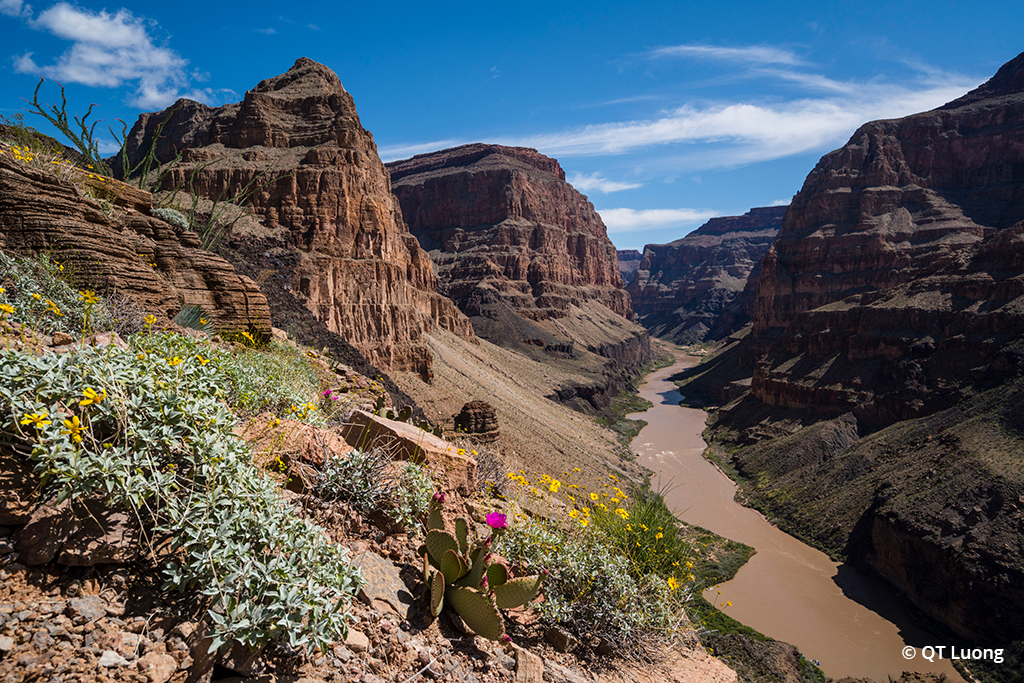
Whitmore Canyon Overlook, morning. Grand Canyon-Parashant National Monument, Arizona.
What Are National Monuments?
Like national parks, national monuments are federally protected areas. They vary in size from less than an acre to surface areas comparable to large U.S. states. They preserve natural or historic features. The main administrative difference is that only Congress can designate a national park, whereas presidents can proclaim a national monument on their own thanks to a 1906 law called the Antiquities Act.
Sixteen presidents have used the Act to preserve some of America’s most treasured public lands and waters. Half of today’s national parks, including Grand Canyon, were first protected as national monuments. In 2017, an unprecedented executive order questioned these designations by calling for the review of 22 national monuments across 11 states, in addition to five marine areas. I spent the next three years endeavoring to photograph those 22 endangered national monuments in depth. For brevity, “national monuments” will refer to those. Here I share some of my findings.
Less Development
The national parks are created for the “benefit and enjoyment of the people.” They are generally equipped with an infrastructure of roads, visitor centers, lodges, campgrounds and interpretive trails. While that makes a visit more convenient, it also brings mass tourism.
For example, Arches National Park is frequently full and closed to new entries by 9 a.m. People instead head to nearby Canyonlands National Park, but even there, securing a spot at sunrise for the iconic Mesa Arch requires arriving well in advance. By contrast, each time I photographed three of the most famous natural arches in nearby Grand Staircase-Escalante National Monument, I had the entire place to myself.
The national monuments are created for conservation. Since 1996, the landscape-sized national monuments have been operated by the Bureau of Lands Management or the U.S. Forest Service instead of the National Park Service. Their development is minimal. Often, facilities are limited to primitive campgrounds and trailheads. Roads can be unpaved, and a 4WD vehicle is recommended, if not necessary.
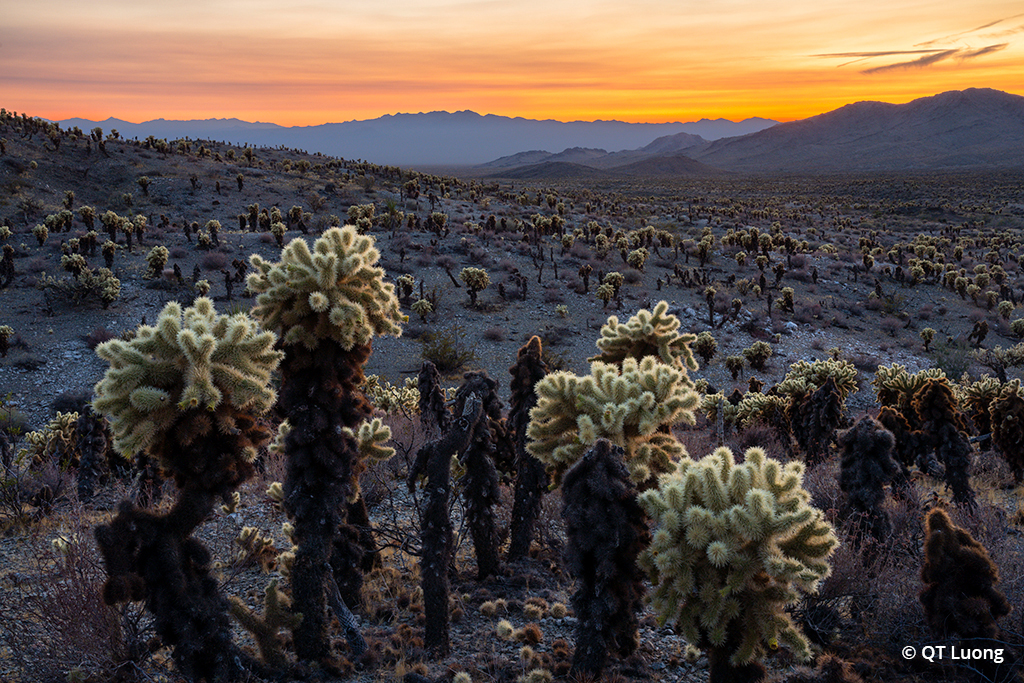
Bigelow Cholla Garden, sunset. Mojave Trails National Monument, California.
Visiting the national monuments managed by the BLM and USFS can test your preparation and self-sufficiency. Most areas are remote and have no cellphone coverage. You must bring everything you need, including food, water and enough gear to survive a night or two should you have an emergency.
With no visitor centers nor rangers around, no brochures nor guidebooks, the first obstacle in my explorations was to find information. My book, Our National Monuments: America’s Hidden Gems, the first about national monuments, provides you with the starting point I wish I had for planning trips. It includes location information for each photograph, some of which is excerpted in this article.
Smaller Crowds
The more adventurous setting of the national monuments results in much lighter visitation, even though you can often find similar subjects and environments as in the nearby national parks. For example:
- The Sonoran Desert portions included in Ironwood Forest National Monument and Sonoran Desert National Monument are as beautiful and representative as those in Saguaro National Park, if not more pristine.
- California’s densest population of cholla cactus thrives in Bigelow Cholla Garden Wilderness of Mojave Trails National Monument, rather than in the better-known Cholla Cactus Garden of Joshua Tree National Park.
- Despite a dozen visits to Death Valley National Park, I could never find the Mesquite Sand Dunes devoid of numerous footprints from other visitors. At Cadiz Dunes Wilderness in Mojave Trails, I saw many animal tracks but no human footprints aside from my own.
- Vermilion Cliffs National Monument’s Paria Canyon is more than twice as long and every bit as impressive as Zion National Park’s Virgin River Narrows. In a full day of hiking, I saw only a dozen people, whereas it is challenging to photograph the Virgin River Narrows without including other hikers.
Fewer Rules
The heavy visitation of national parks led to strict rules. In Grand Canyon National Park, like in any other national park, no car camping is allowed outside developed campgrounds. In nearby Grand Canyon-Parashant National Monument, I could drive right to the edge of the chasm and pitch my tent a few yards away from where I made my sunset photographs, both at Twin Point on the Upper Rim and Whitmore Overlook on the Lower Rim. That spot offered a much shorter hike to the river than the South Rim. Mount Logan featured a high view of the entire Grand Canyon ecosystem without equivalent in the national park.
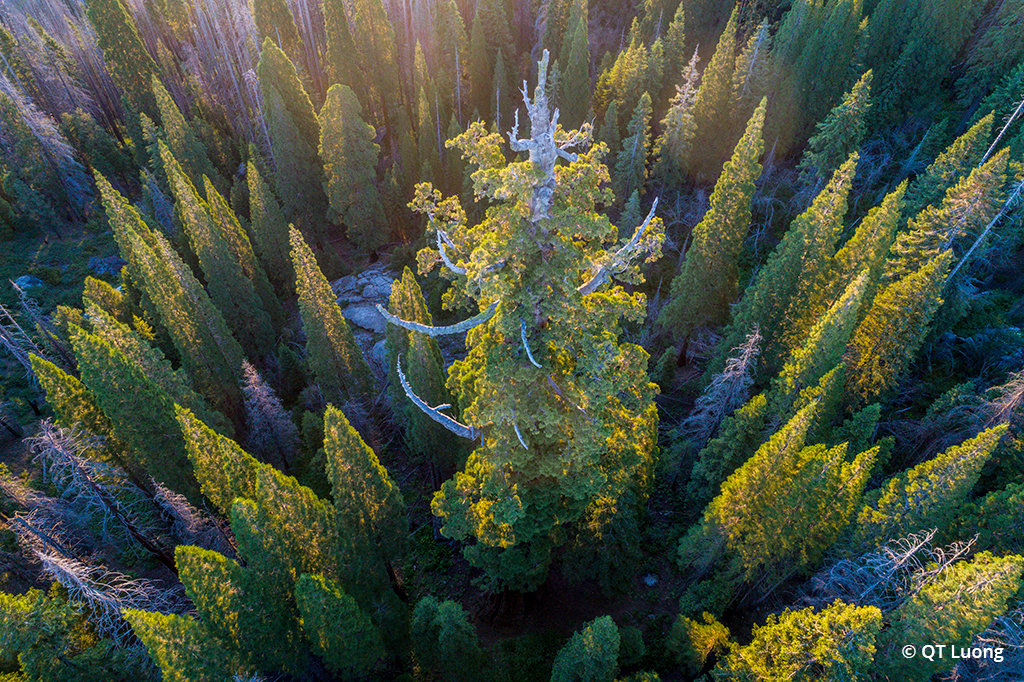
Aerial view of Boole Tree. Giant Sequoia National Monument, California.
Giant Sequoia National Monument protects more sequoia groves—almost half of the total number—than Sequoia and Kings National Parks combined. Because it has the largest diameter (36 feet) of any living giant sequoia, the Boole Tree was once considered the largest tree in the world, although it is “only” the sixth largest by volume. Unsightly railings protect the biggest trees in the national parks, but there are no fences around the Boole Tree. Unlike in the national parks, drones are allowed in national monuments. With nobody around to disturb, I sent my drone out in the air at sunrise, capturing the tip of the tree hardly visible from the ground.
Even if the national monuments were only lesser-traveled alternatives to bustling national parks, they would be worthwhile destinations. However, some of the most remarkable nature subjects in North America are in national monuments rather than national parks. Here are a few locations ideally visited in autumn or spring.
Coyote Buttes, Vermilion Cliffs National Monument
“The Wave” in Arizona is known worldwide. Even if the name Vermilion Cliffs National Monument is unfamiliar, you have undoubtedly seen images of the extraordinary rock formation located in Coyote Buttes North. For decades, only 20 permits were issued daily. If you have been trying to win the lottery, take hope in the increase this year to 64 permits. A geologic wonderland of spectacularly colored rock strata, the area protects much more than the Wave.
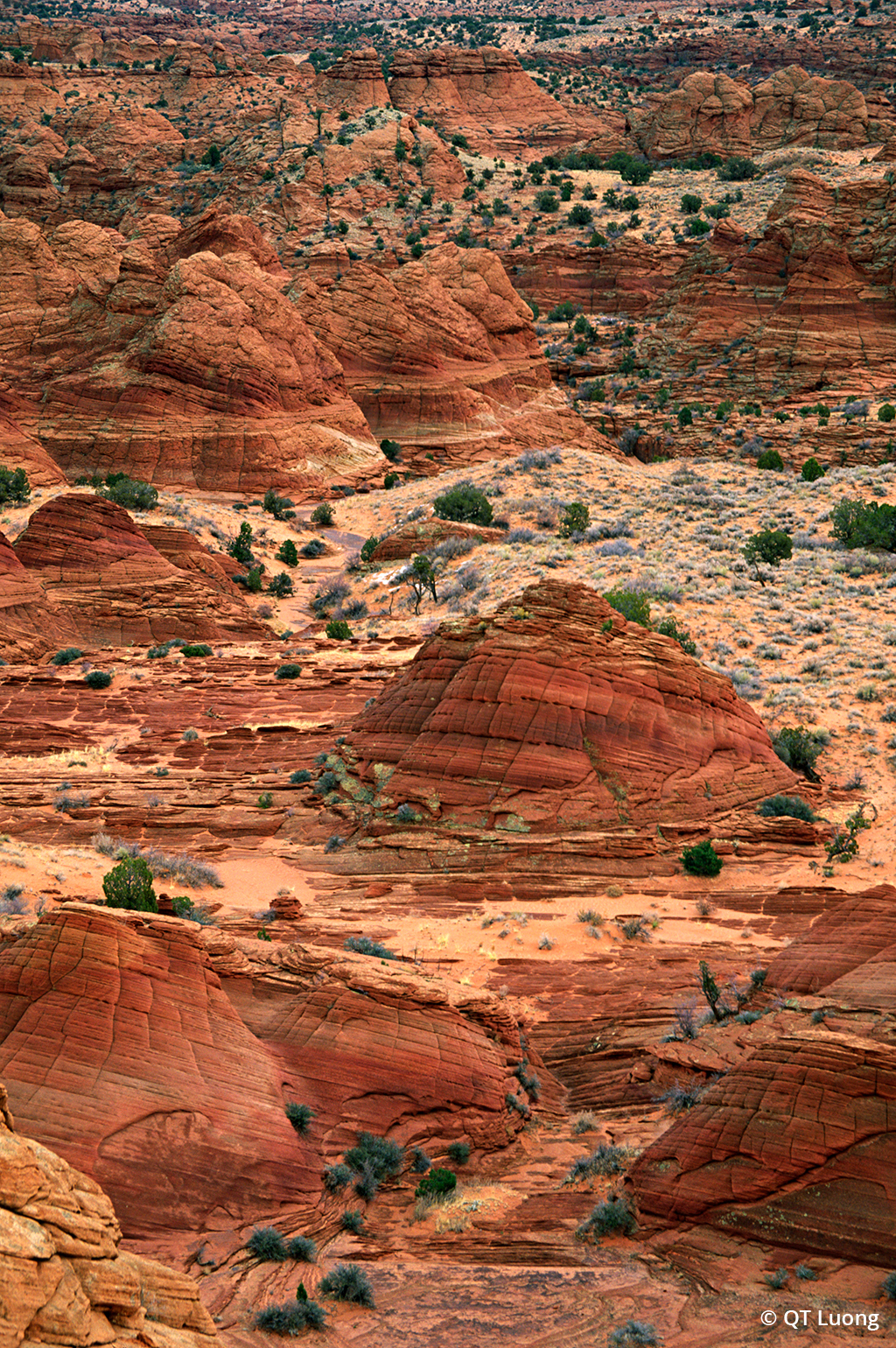
Sandstone mounds, North Coyote Buttes. Vermilion Cliffs National Monument, Arizona.
Coyote Buttes South has equally amazing slickrock swirls, but the odds of winning a permit are much higher. However, getting to the trailhead requires a high clearance 4WD vehicle. If you have one and did not win a permit, a great alternative is to visit White Pocket. Be sure to obtain the map with the BLM’s recommended route, as others can be very challenging. You can walk across White Pocket in 15 minutes, but that small area is a landscape photographer’s dream. Rocks are incredibly twisted with cauliflower and brain shapes. The unusual white layer after which the entire area was named caps red sandstone, creating great contrasts.
Little Finland, Gold Butte National Monument
A kaleidoscopic and lively desert punctuated by brightly colored rocks and ancient petroglyphs, Gold Butte National Monument protects a huge section of Nevada northeast of Las Vegas. The monument lies at the meeting of the Mojave Desert with the red rocks of the Colorado Plateau. Brightly colored sandstone formations stand out in the vast and rugged desert scenery.
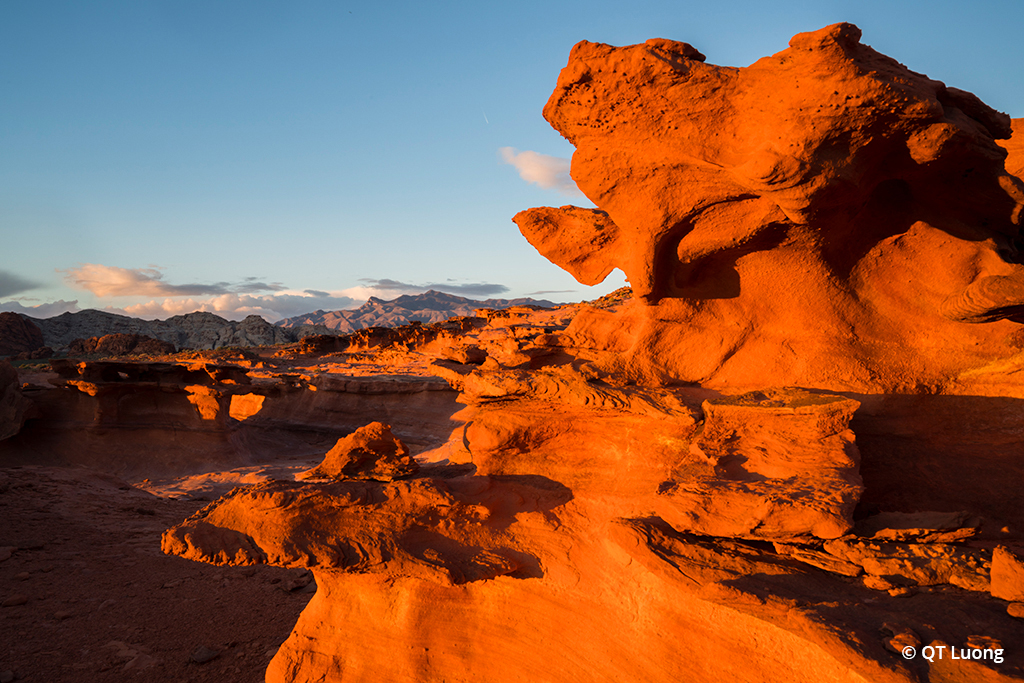
Little Finland, sunset. Gold Butte National Monument, Nevada.
Although small at about 2,000 feet by 500 feet, the Little Finland area houses rock formations unique even in a region—the American Southwest—known for its geology. The erosion process there has resulted in countless gravity-defying, detached thin fins of stone with intricate shapes. The natural sculpture garden reminded me of cave formations. Be sure not to damage the ornate and fragile fins that have taken millions of years to form. They are atop a mesa sloping toward the west and bordered by a tall hill blocking the sunrise on the east, two reasons to photograph the area in late afternoon. Driving to the remote Little Finland area requires a 4WD vehicle.
Zebra Slot Canyon, Grand Staircase-Escalante National Monument
A wild and beautiful country of multicolored slickrock, Grand Staircase-Escalante National Monument in Utah encompasses an area so remote it was the last region in the contiguous United States to have been mapped. Despite its remoteness, some of the unpaved roads in the monument are accessible with a regular car driven carefully. They give access to two of the arches mentioned earlier, Grosvenor Arch off Cottonwood Canyon Road and Metate Arch in Devils Garden off Hole-in-the-Rock Road near Boulder, Utah.
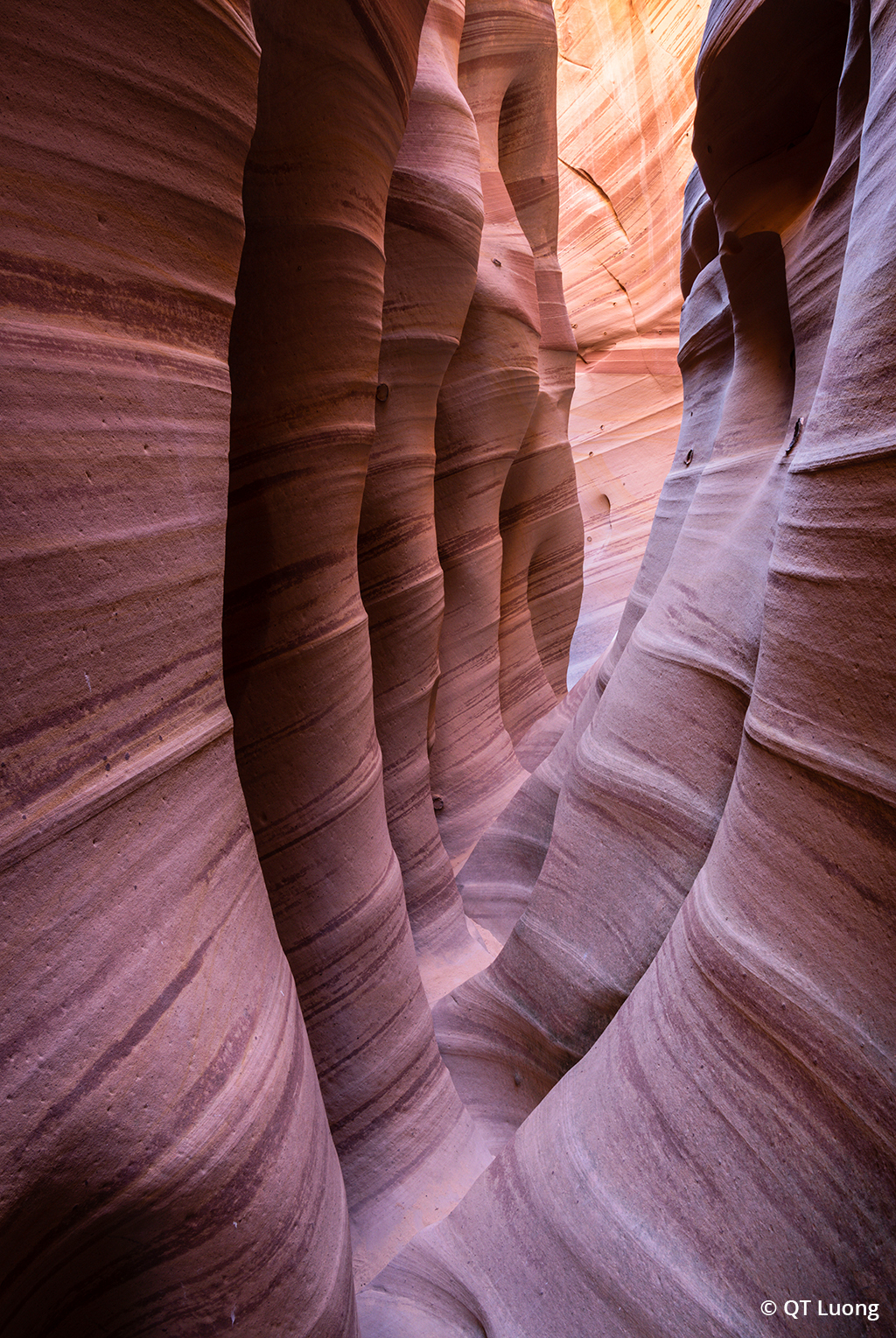
Zebra Slot Canyon, midday. Grand Staircase Escalante National Monument, Utah.
Hole-in-the-Rock Road also leads to numerous slot canyons of diverse character. With its pillars, encrusted Moqui stones and multicolored striations that inspired its name, Zebra is one of the most unique slot canyons I have seen. It is reached via a 5.2-mile (roundtrip) hike starting at mile 7.8. In November, I found it dry, but there might be ankle- to chest-deep standing water at other times. The canyon was so narrow, I could not squeeze in with my camera backpack. I left the pack in a corner, heading out with only a camera and tripod. The latter was necessary because blending several frames focused at different distances was the only way to get everything in focus.
Valley of the Gods, Bears Ears National Monument
Bears Ears National Monument in Utah spans wondrous red rock country. Hidden in its labyrinth of canyons and mesas are more cliff dwellings and tribal artifacts than any other area in the American West. The road descending the Cedar Mesa plateau, called Moki Dugway, is impressive for its precipitous surroundings and 180-degree switchbacks cut into the cliff. The vista from there is immense.
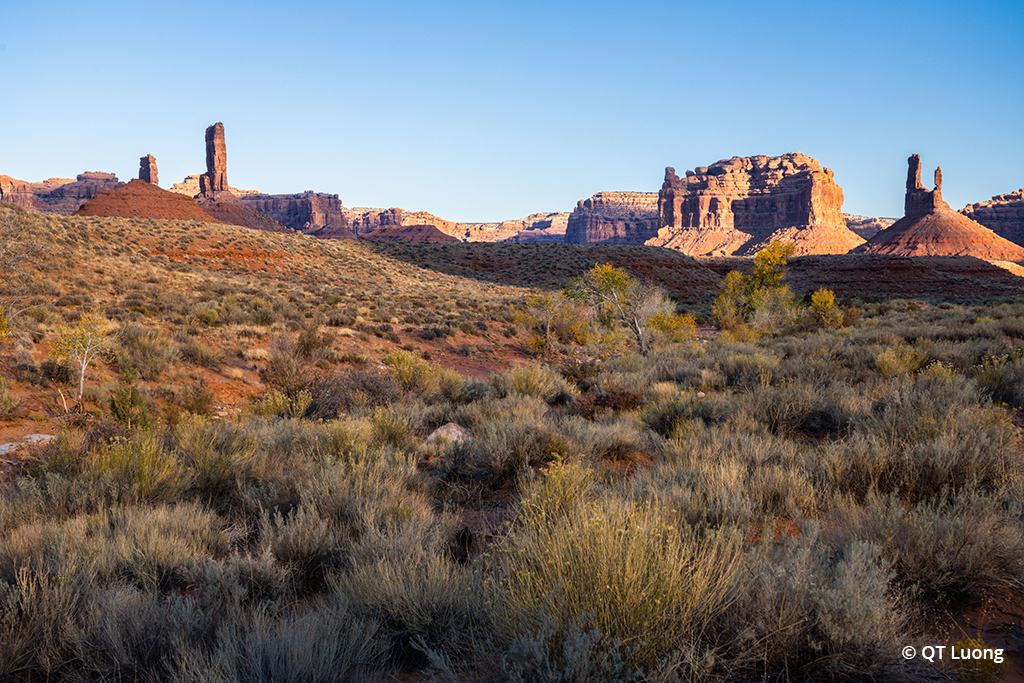
Valley of the Gods, early morning. Bears Ears National Monument, Utah.
A sandy plain dotted with sandstone buttes and spires near Mexican Hat, Utah, Valley of the Gods’ landscape reminded me of Monument Valley. While the rock formations are smaller, Valley of the Gods is free from commercialization, tour groups, streams of cars and heavy regulations. Instead, I found quiet, solitude and freedom to explore. I could come and go as I pleased to catch sunrise and sunset, finding plenty of spots to camp for free. The 17-mile unpaved road is passable by a 2WD car driven carefully.
The Future Of Public Lands
Since 1906, America’s boldest efforts in conservation have been through the establishment of national monuments via presidential proclamation. Grand Staircase-Escalante was the first of the national monuments managed by the BLM, marking the evolution of the nation’s largest land caretaker toward conservation. Bear Ears was the first native-driven and co-managed national monument. Both saw their size drastically reduced by the previous administration.
Many spots in national parks have become icons of our natural and cultural heritage to the point that they have become over-photographed, making it difficult to find original compositions. The national monuments offer new landscapes and natural wonders awaiting exploration. Their often starker and more subtle landscapes invite exploration to get to know and love. Because the natural features are less prominent, it is easier to pay attention to the small details that make up the ecosystem. The absence of postcard views frees you of pre-conceptions that hinder personal discovery. As the national parks become ever more popular, the national monuments’ vast open spaces offer us places of solitude and inspiration.
See more of QT Luong’s work at terragalleria.com.
The post Hidden Gems Of Our National Monuments appeared first on Outdoor Photographer.

